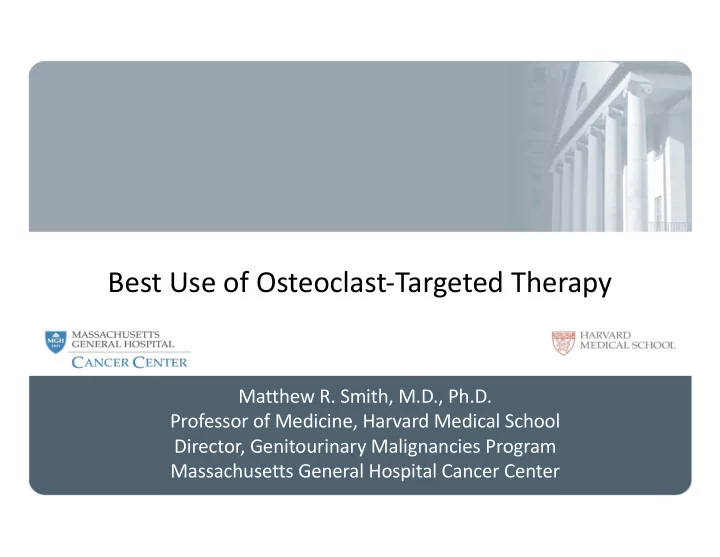

Best Use of Osteoclast-Targeted Therapy Matthew R. Smith, M.D., Ph.D. Professor of Medicine, Harvard Medical School Director, Genitourinary Malignancies Program Massachusetts General Hospital Cancer Center
Disclosures Personal financial interests Consultant: Amgen, Astellas, Bayer, Clovis, Gilead, Janssen, Lilly, Novartis, Pfizer Institutional financial interests Contracted clinical research: Amgen, Bayer, Clovis, Gilead, Janssen, Lilly
Skeletal-Related Events vs Fragility Fractures/Osteoprosis Fragility Fractures/ Skeletal-Related Events Osteoporosis Population at Risk All men mCRPC, bone metastases Anatomic site normal bone bone metastases Effects of cancer treatment: ADT • Abiraterone acetate • • Enzalutamide Osteoclast activation + +++
FDA Approved Uses of Osteoclast-Targeted Therapy Fragility Fractures/ Skeletal-Related Events Osteoporosis � Oral bisphosphonates (alendronate, risedronate, ibandronate) Zoledronic acid � 5 mg q12 months (Reclast) • � 4 mg q3-4 weeks (Zometa) • Denosumab 60 mg every 6 months (Prolia) � • 120 mg q4 weeks (Xgeva) � •
National Osteoporosis Foundation (NOF) Fracture Prevention Guidelines for Men Consider FDA-approved medical therapies based on the following: § A vertebral or hip fracture § Femoral neck or spine T-score ≤ -2.5 § FRAX 10-year probability of a hip fracture ≥ 3% or 10-year probability of any major fracture ≥ 20% National Osteoporosis Foundation, www.nof.org, accessed August 2019
Most Fractures Occur in Patients without Osteoporosis National Osteoporosis Risk Assessment (NORA): § 149,524 post-menopausal women, mean age of 65 years § 82% of 2,259 women with fragility fractures had baseline T-score>-2.5 Siris et al (2004) Arch Intern Med 164: 1108-1112
FDA Approved Uses of Osteoclast-Targeted Therapy Fragility Fractures/ Skeletal-Related Events Osteoporosis � Oral bisphosphonates (alendronate, risedronate, ibandronate) Zoledronic acid � 5 mg q12 months (Reclast) • � 4 mg q3-4 weeks (Zometa) • Denosumab 60 mg every 6 months (Prolia) � • 120 mg q4 weeks (Xgeva) � •
Markers of Osteoblast (BAP) and Osteoclast (NTx) Activity in Men with mCRPC and Bone Metastases Correlation coefficient = 0.67 ( Osteoblast Activity ) BAP (U/L) Normal NTx (nmol/mmol creatinine) ( Osteoclast Activity ) Cook et al (2006) Clin Cancer Res
CALGB 70604: Longer Interval vs Standard Dosing of Zoledronic Acid and SREs in Patients with Bone Metastases Differences in osteoclast inhibition but not SRE incidence Cumulative Incidence of Skeletal-Related Events or Death Changes in C-Telopeptide Levels Himelstein et al (2017) JAMA 317: 48-58
Limitations of CALGB 70604 § There can be no assumption of constancy, a requirement for valid inference for non-inferiority studies 1 § Substantial changes in standards of care, event rate, and survival § Included some patients (men with HSPC) with no potential for benefit 2,3 § SRE definition differed from prior studies § Primary analysis was 24 month event rate, but only 43% completed the study at 2 years (median follow-up only 14 months) § Non-inferiority margin included clinically important difference § Longer dosing interval did not improve safety/tolerability 1 Koopmeiners and Hobbs (2018) Stat Methods Med Res 27: 1547-1558 2 Smith et al (2014) J Clin Oncol 32:1143-50 3 James et al (2016) Lancet 387:1163-77
Conclusions: Fragility Fractures/Osteoporosis § Fragility fractures are common in men § Age, prior fractures, and low BMD are strongest predictors of fracture § In men with prostate cancer, fracture risk is increased by androgen deprivation therapy and androgen pathway inhibitors (abiraterone plus prednisone, apalutamide, enzalutamide) § Assessment of fracture risk should include evaluation of BOTH clinical risk factors and BMD § Treatment-related fractures are preventable
Conclusions: Skeletal-Related Events (SREs) § SREs are a distinct set of clinical problems related to cancer progression in bone § Approved therapies for osteoporosis (drug/dose/schedule) are not sufficient to prevent SREs § Zoledronic acid (4 mg every 3-4 weeks) and denosumab (120 mg every 4 weeks) significantly decrease SREs in mCRPC and bone metastases § Zoledronic acid (4 mg every 12 weeks) might be sufficient for SRE prevention but evidence for efficacy is weak and no proven safety benefit § Optimal treatment duration for SRE prevention is undefined
Thank you!
APCCC 2019 Key Questions for Prevention of Skeletal Related Events (SREs) 90. Do you recommend osteoclast-targeted therapy (zoledronic acid or denosumab) at the higher dose and more frequent schedule used for reducing the risk of SREs in patients with CRPC and bone metastases? YES, there is no evidence that drug/dose/schedule approved for osteoporosis is adequate to prevent disease-related skeletal morbidity (SREs) 93. When you use osteoclast-targeted therapy at the dose and schedule used for reducing the risk of SRE in patients with mCRPC and bone metastases, what treatment frequency do you recommend? Every 4 weeks although optimal schedule is undefined
APCCC 2019 Key Questions about Fracture Prevention 85. Do you routinely screen for osteoporosis (fracture) risk factors in patients with prostate cancer starting on long-term ADT? YES, most fractures occur in patients with normal BMD 86. Do you routinely recommend measurement of bone mineral density (BMD) in patients with prostate cancer starting on long-term ADT? YES, but BMD measurement alone is not sufficient to evaluate fracture risk 87. Is it appropriate to start an osteoclast-targeted therapy (osteoporosis dose/schedule) to prevent fractures without BMD measurement? YES, particularly in patients who are at high risk for fracture based on clinical assessment
Zoledronic Acid vs Placebo in Men with mCRPC and Bone Metastases Potent osteoclast inhibition significantly decreased SREs Time to First Skeletal-Related Events Changes in Urinary NTx Zoledronic acid vs placebo q3 weeks for 24 months Saad et al (2002) JNCI 94: 1458-1468
Denosumab versus Zoledronic Acid in Men with mCRPC and Bone Metastases More potent osteoclast inhibition further decreased SREs Cumulative Incidence of Skeletal-Related Events Changes in Bone Turnover Markers Denosumab vs Zoledronic acid q4 weeks indefinitely Fizazi et al (2011) Lancet 377: 813–822
Assessment of Fracture Risk § Age, prior fracture history, and low BMD are the strongest predictors of fracture risk in men § Most fragility fractures occur in individuals with normal BMD § BMD alone is insufficient to evaluate fracture risk Kanis et al (2005) Osteoporos Int 16(6):581; Lewiecki et al (2019) UpToDate
Recommend
More recommend